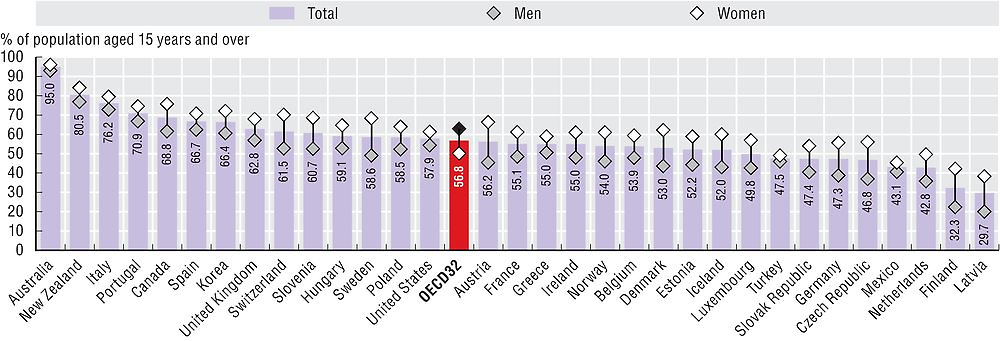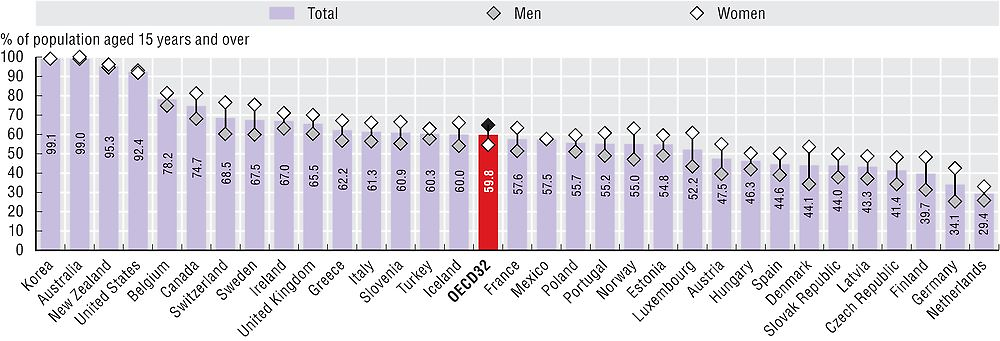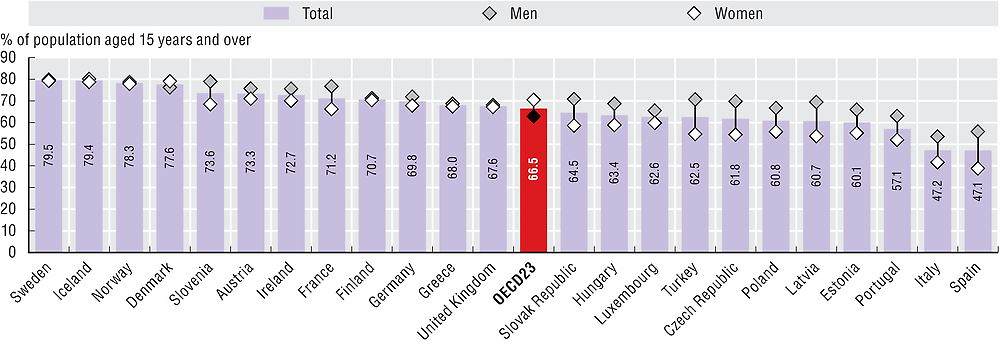Healthy lifestyles among adults
Low fruit consumption, low vegetable consumption, and low levels of physical activity are among the ten leading risk factors in terms of years of healthy life lost in 24, 6, and 16 OECD countries respectively (Forouzanfar et al., 2016). Worldwide, diets low in fruit were the cause of nearly 3 million deaths in 2015, while low vegetable consumption caused nearly 2 million deaths, and low physical activity caused 1.6 million deaths. Including fruit and vegetables in the daily diet reduces the risk of coronary heart disease, stroke, as well as certain types of cancer (WHO, 2014). They include dietary fibre which lowers blood pressure and regulates insulin, possibly impacting the risk of type 2 diabetes (InterAct Consortium, 2015). Regular physical activity improves muscular and cardiorespiratory fitness, and reduces the risk of hypertension, coronary heart disease, stroke, diabetes, and various cancers (WHO, 2017). It has also been shown to positively impact mental health (Lindwall et al., 2012). In adults, the WHO recommends at least 150 minutes of moderate-intensity physical activity per week, at least 75 minutes of vigorous-intensity physical activity per week, or an equivalent combination of the two (WHO, 2017).
Fifty-seven per cent of adults across the OECD consume fruit daily, with values ranging from 30-35% in Finland and Latvia, to over 70% in Australia, Italy, New Zealand and Portugal (Figure 4.8). Women consume more fruit than men in all countries, and display the highest rates of consumption in Australia, Canada, Italy and New Zealand (over 75%). Meanwhile, they display the lowest rates in Finland, Latvia, Mexico, the Netherlands and Turkey (under 50%). Levels of consumption for men are highest in Australia, Canada, Italy, Korea, New Zealand, Portugal and Spain (over 60%), while they are lowest in Finland, and Latvia (below 30%). Gender gaps are largest in Austria, the Czech Republic, Denmark, Finland, Germany, Iceland, Latvia, Norway, Slovenia, Sweden and Switzerland (15-20 points), and lowest in Australia, Mexico and Turkey (under 5 points). Overall, 63% of women in the OECD consume fruit daily, while 50% of men do.

Note: Data for Australia, Korea and New Zealand are derived from quantity-type questions. Data for the United States include juice made from concentrate.
Source: OECD Health Statistics 2017.
Vegetable consumption is higher than fruit consumption (Figure 4.9). On average, 60% of people in the OECD consume vegetables daily (65% of women, and 55% of men). Rates are highest in Australia, Korea, New Zealand and the United States, with over 90% of people reporting eating vegetables daily, although the methodology differs across countries (see Definition and comparability). On the other end of the spectrum, fewer than 40% report doing so in Finland, Germany and the Netherlands. In the United States, men consume slightly more vegetables than women, and in Korea and Mexico they consume the same amount; in all other countries, women consume more vegetables than men. Gender gaps are large in Austria, Denmark, Finland, Germany, Luxembourg, Norway, Sweden and Switzerland (15-19 points).

Note: Data for Australia, Korea and New Zealand are derived from quantity-type questions. Data for the United States include juice made from concentrate.
Source: OECD Health Statistics 2017.
Over 70% of adults perform at least 150 minutes of moderate physical activity weekly in Austria, Denmark, Finland, France, Iceland, Ireland, Norway, Slovenia and Sweden (Figure 4.10). In Portugal, Italy and Spain, fewer than 60% meet the WHO recommendation. Across the OECD, an average of 66.5% of people perform 150 minutes of moderate physical activity per week, with 70.5% of men and 63% of women. Men are more physically active than women in all countries but Denmark. The gap is particularly high (over 15 points) in the Czech Republic, Latvia, Turkey and Spain.

Source: Eurostat EHIS 2014.
Fruit and vegetable consumption is defined as the proportion of individuals consuming at least one fruit or vegetable per day. Data rely on self-reporting and are subject to errors in recall.
Data for Australia, Korea and New Zealand are derived from quantity-type questions. Data from the United States include juice made from concentrate. In these countries, values may be overestimated as compared with other countries. Most countries report data for the population aged 15 +, but there are some exceptions as highlighted in the data source of the OECD Health Statistics database.
The indicator of moderate physical activity is defined as doing at least 150 minutes of moderate physical activity per week. Estimates of moderate physical activity are based on self-reports from the European Health Interview Survey 2014, combining work-related physical activity with leisure-time physical activity (bicycling for transportation and sport). Walking for transportation is not included.
References
Forouzanfar, M.H. et al. (2016), “Global, Regional, and National Comparative Risk Assessment of 79 Behavioural, Environmental and Occupational, and Metabolic Risks or Clusters of Risks, 1990–2015: A Systematic Analysis for the Global Burden of Disease Study 2015”, The Lancet, Vol. 388, pp. 1659-1724.
Lindwall, M. et al. (2012), “Self-Reported Physical Activity and Aerobic Fitness are Differently Related to Mental Health”, Mental Health and Physical Activity, Vol. 5, No. 1, pp. 28-34.
The InterAct Consortium (2015), “Dietary Fibre and Incidence of Type 2 Diabetes in Eight European Countries: The EPIC-InterAct Study and a Meta-analysis of Prospective Studies”, Diabetologia, Vol. 58, pp. 1394–1408.
WHO (2017), “Fact Sheet on Physical Activity”.
WHO (2014), “Increasing Fruit and Vegetable Consumption to Reduce the Risk of Noncommunicable Diseases”.
